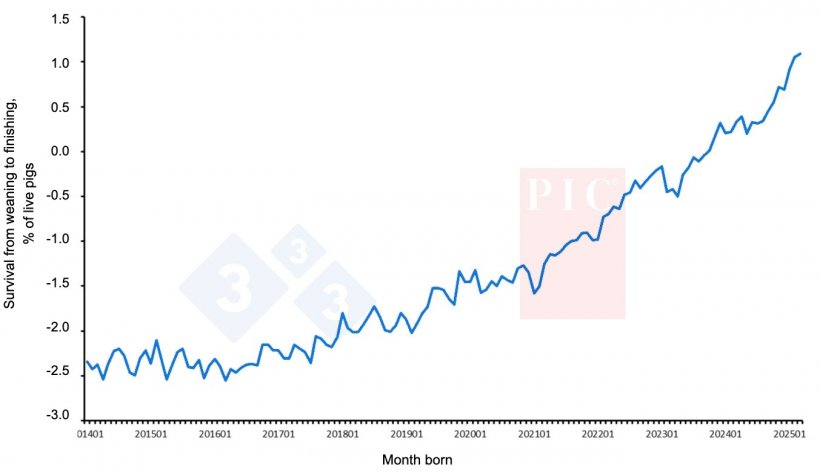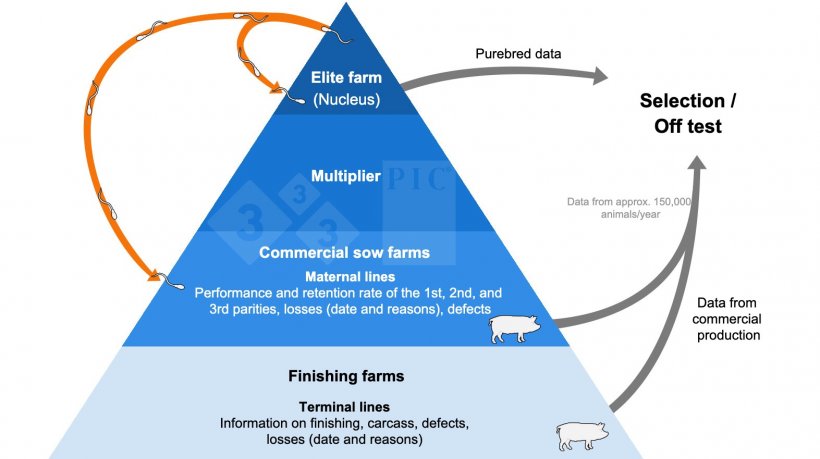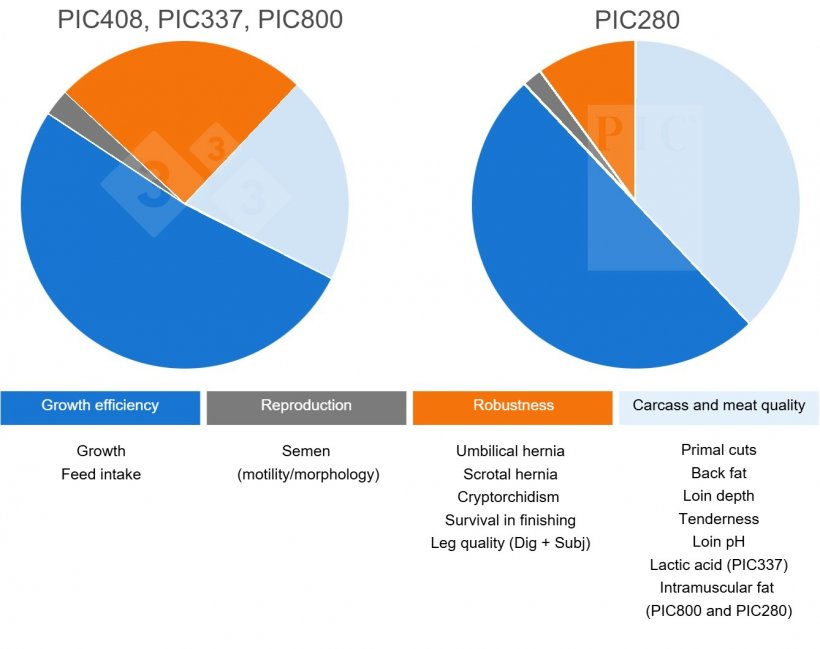The selection programs developed by genetic improvement companies have the fundamental objective of accelerating genetic progress, in order to subsequently disseminate this improvement to comercial farms and thus increase the producer's profitability.
The pillars of PIC's genetic program can be summarized as follows:

- Large-scale implementation of genomic selection
- Extensive data collection from comercial farms, with a strong emphasis on efficient growth and robustness
- Increase in large and diverse elite populations
The combination of these elements explains the rapid improvements observed in robustness, faster and more efficient growth, and high carcass value. However, the increase in genetic potential generated would not be observed on farms without advances in nutrition, biosecurity, facilities, and farm management.
Genomic selection
After the introduction of BLUP in 1991, the next important milestone in animal breeding and selection was the introduction of Relationship-Based Genomic Selection (RBGS). The implementation of genomic selection is based on incorporating DNA information, consisting of thousands of points in the genome of all animals born in genetic nucle, into genetic evaluations to estimate the genetic value of breeding animals. PIC has been using genomic selection since 2013 in all its lines, which has increased the accuracy to identify genetically superior animals by 35%. The increaisse in accuracy resulting from the incorporation of genomic information has been fundamental in achieving the high rates of genetic progress observed over the last 10 years.
PIC currently performs the genotyping of more than 400,000 animals each year, including 100% of purebred boars from elite farms at birth and 100% of active sows on those farms.
In other words, every terminal sire producing semen doses, their parents (sire and dam), and their siblings in production have all been genotyped. This large-scale genotyping strategy is associated with highly accurate genetic evaluations for all traits included in the breeding program.
GNX Program: Greater emphasis on selection for growth and robustness
PIC genetic evaluations include more than just the data measured in the genetic nucleus (which would constitute a basic selection program). For more than 20 years, in all terminal lines, this information has been combined with data from animals closely related to the selection candidates located in the genetic nucleus but raised and slaughtered under commercial conditions . Specifically, the following traits are measured with great precision:
- Robustness: Such as survival throughout the production phase and defects (umbilical hernias, scrotal hernias, cryptorchidism)
- Carcass and meat quality characteristics.
This strategy allows PIC to select future breeding stock from its genetic pools based on the performance of their relatives in commercial systems. More than 150,000 animals raised under commercial conditions pass through the GNX program each year.
The objective of the GNX program is to obtain information about animal performance under commercial conditions, which is where our customers' farms usually are, and to place greater emphasis on improving robustness and carcass quality.

Genetic trend for survival in finishing pigs. The decrease in mortality in finishing pigs, measured as the increase in survival from weaning to slaughter, is one of the traits that benefits most from the data generated by the GNX program. The graph shows how survival potential has increased by 3.5% over the last 10 years.

GNX Program
Digital phenotyping: PIC has recently incorporated digital phenotyping into its breeding program to increase objectivity and accuracy in leg conformation and movement quality evaluations. This tool surpasses traditional leg conformation and movement quality evaluations in terms of objectivity and accuracy, resulting in a significant increase in heritability and, therefore, a faster improvement in the leg conformation of breeding stock.
Increase in the number of elite breeding stock
Over the last five years, the population on Elite farms focused on improving terminal boar lines has doubled, with a particularly notable increase in the number of Duroc sows, which has increased tenfold worldwide to accelerate the improvement of the PIC800 and PIC280 lines.
A greater number of elite breeding animals greatly enhances the efficiency of the improvement program because:
- It allows for greater selection intensity, which is one of the main parameters in the speed of improvement.
- Larger and more diverse populations imply greater variability and, with it, greater selection capacity for emerging traits. In this way, we are more likely to detect animals of high value for traditional traits and for new traits that are being updated in the improvement program.
- Having populations located on different farms, in different countries, and on different continents creates greater contingency or diversified production based on having elite genetic animals from each line so that the supply of high genetic value animals can be maintained, even during health and geopolitical challenges that could interrupt the supply chain.
Terminal line improvement programs: Efficiency and quality do not have to be incompatible
PIC terminal line improvement programs can be divided into two main groups according to selection objectives:

The PIC337, PIC800, and PIC408 improvement programs are highly focused on rapid and continuous improvement of traits directly associated with the overall profitability of the system, such as growth rate, feed conversion, and robustness, among others, while maintaining optimal meat quality.
The PIC280 line, however, takes a different approach, as its primary objective is to improve meat quality characteristics such as intramuscular fat, tenderness, and pH without sacrificing production efficiency.

Selection Objectives in PIC Terminal Lines
These examples of selection objectives in different lines show that a modern improvement program, regardless of the terminal sire line, should focus on producing a balanced end product that is highly profitable for both the farmer and the processing plant. To achieve this, the programs for each terminal line include approximately 20 traits that can be grouped into four major groups:
- Growth rate and efficiency
- Robustness (especially survival in growing- finishing phase)
- Carcass characteristics
- Meat quality
The simultaneous improvement of all these traits can be achieved through modern genetic improvement programs, supported by significant investment in population size and diversity and the implementation of advanced technologies applied to the collection and analysis of phenotypic and genomic data. Once high genetic potential has been generated, advances in areas such as nutrition, biosecurity, facilities, and farm management will allow animals to express that potential and will enable producers to see the impressive acceleration of genetic potential that we are currently observing in PIC terminal lines.



